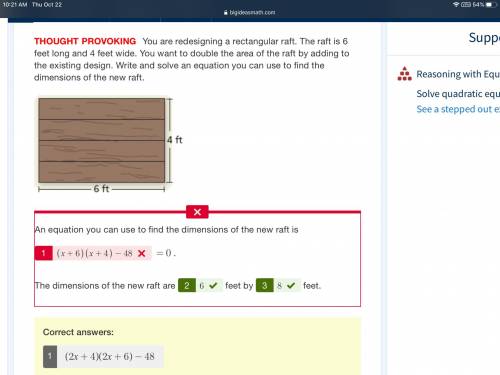
Mathematics, 22.10.2020 18:01 adelfaali99
Explain the answer to this quadratic equation question. Correct explanation will be marked big brain My question is: why is it (2x + 4)(2x + 6) and not (x + 6)(x + 4)?


Answers: 3
Another question on Mathematics

Mathematics, 21.06.2019 13:30
Adaylily farm sells a portion of their daylilies and allows a portion to grow and divide. the recursive formula an=1.5(an-1)-100 represents the number of daylilies, a, after n years. after the fifth year, the farmers estimate they have 2225 daylilies. how many daylilies were on the farm after the first year?
Answers: 2


Mathematics, 21.06.2019 20:30
Martha has a deck of cards. she has lost some of the cards, and now the deck only contains nine spades, eleven diamonds, eight clubs, and twelve hearts. martha predicts that whenever she draws a card from the deck without looking, she will draw a club one-fifth of the time. which activity would best allow martha to test her prediction? a. randomly draw a card from the box and see if it is a club. b. randomly draw a card. then, continue to draw another card until all eight clubs are drawn. c. randomly draw and replace a card 120 times. then, observe how close to 30 times a club is drawn. d. randomly draw and replace a card 100 times. then, observe how close to 20 times a club is drawn.
Answers: 1

Mathematics, 21.06.2019 21:30
In a test for esp (extrasensory perception), the experimenter looks at cards that are hidden from the subject. each card contains either a star, a circle, a wave, a cross or a square.(five shapes) as the experimenter looks at each of 20 cards in turn, the subject names the shape on the card. when the esp study described above discovers a subject whose performance appears to be better than guessing, the study continues at greater length. the experimenter looks at many cards bearing one of five shapes (star, square, circle, wave, and cross) in an order determined by random numbers. the subject cannot see the experimenter as he looks at each card in turn, in order to avoid any possible nonverbal clues. the answers of a subject who does not have esp should be independent observations, each with probability 1/5 of success. we record 1000 attempts. which of the following assumptions must be met in order to solve this problem? it's reasonable to assume normality 0.8(1000), 0.2(1000)%30 approximately normal 0.8(1000), 0.2(1000)% 10 approximately normal srs it is reasonable to assume the total number of cards is over 10,000 it is reasonable to assume the total number of cards is over 1000
Answers: 1
You know the right answer?
Explain the answer to this quadratic equation question. Correct explanation will be marked big brain...
Questions



Mathematics, 25.09.2020 03:01


History, 25.09.2020 03:01



Arts, 25.09.2020 03:01


Biology, 25.09.2020 03:01




Mathematics, 25.09.2020 03:01

Mathematics, 25.09.2020 03:01







